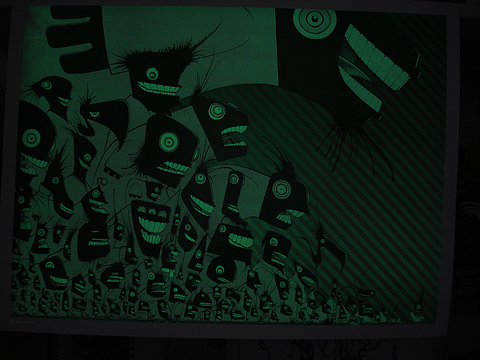MONSTROLUMINESCENT PHOTOS

Good evening. You know how I couldn’t get photos of the new glow-in-the-dark Monsters yesterday? Well, turns out all you need is a 500W bulb to charge the ink, a tripod, a 30 second exposure with a few second of faint ambient light from an open closet door:


Where there’s a will there’s a way.
The Monsters won’t be denied
their moment out of the sun.
I hope you’ll have a brilliant weekend.
Please keep in mind that 344 LOVES YOU
—–
By the way, did you know?
Simple explanation
In simple terms, phosphorescence is a process in which energy absorbed by a substance is released relatively slowly in the form of light. This is in some cases the mechanism used for “glow-in-the-dark” materials which are “charged” by exposure to light. Unlike the relatively swift reactions in a common fluorescent tube, phosphorescent materials used for these materials absorb the energy and “store” it for a longer time as the subatomic reactions required to re-emit the light occur less often.
Quantum mechanical explanation
Most photoluminescent events, in which a chemical substrate absorbs and then re-emits a photon of light, are fast, on the order of 10 nanoseconds. However, for light to be absorbed and emitted at these fast time scales, the energy of the photons involved (i.e. the wavelength of the light) must be carefully tuned according to the rules of quantum mechanics to match the available energy states and allowed transitions of the substrate. In the special case of phosphorescence, the absorbed photon energy undergoes an unusual intersystem crossing into an energy state of higher spin multiplicity (see term symbol), usually a triplet state. As a result, the energy can become trapped in the triplet state with only quantum mechanically “forbidden” transitions available to return to the lower energy state. These transitions, although “forbidden”, will still occur but are kinetically unfavored and thus progress at significantly slower time scales. Most phosphorescent compounds are still relatively fast emitters, with triplet lifetimes on the order of milliseconds. However, some compounds have triplet lifetimes up to minutes or even hours, allowing these substances to effectively store light energy in the form of very slowly degrading excited electron states. If the phosphorescent quantum yield is high, these substances will release significant amounts of light over long time scales, creating so-called “glow-in-the-dark” materials.
Thank you, Wikipedia!
OH MY GOSH!!!!
The g-i-t-d monsters are cool and all but I got my Metal for Monsters necklace today and I have been richly rewarded for having your blog in my reader – MINE IS #1 OF 100!!!!
YAY!!
Thanks!!
“The monsters will not be denied” has me lmao!
🙂
ptttththth.
photoluminewhaa?
pretty picture.
These are beautiful, Stefan!
Oh, it’s not enough with all the talent you got to have the big fat brain as well! I like trying to read that kind of stuff, it makes my mind go all nice and blank ;-).